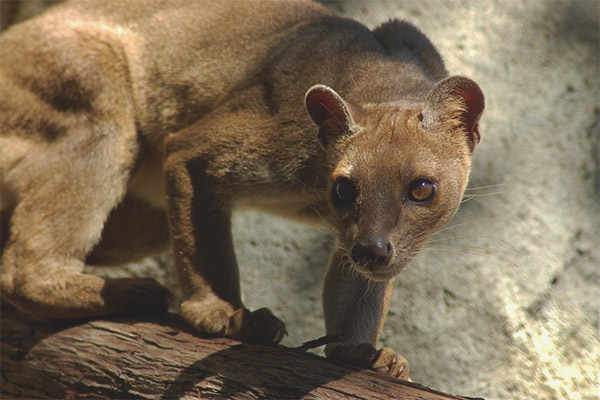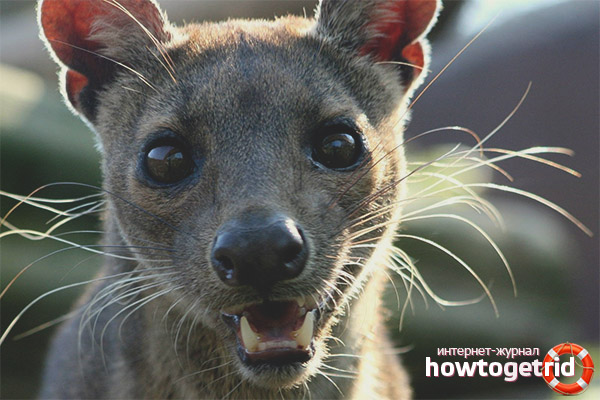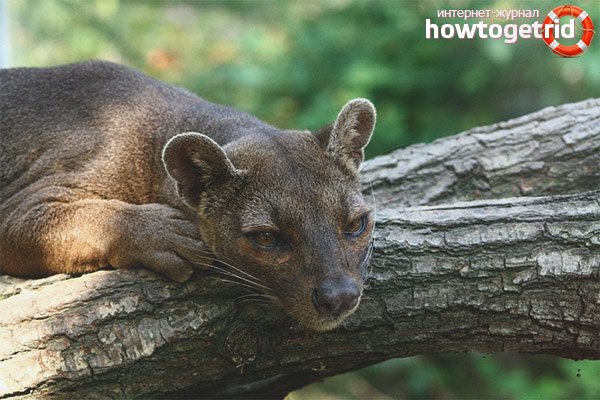The content of the article
By fossa is meant a large-sized beast that lives in Madagascar. Of the local animal population, this wild animal is considered the largest. It hunts preferably on lemurs, skillfully climbs trees and differs in other interesting habits. This material is devoted to foss, its main characteristics and lifestyle. Let us analyze the main criteria in order so that you can form your own opinion.
Habitat and features
- Individuals of this species certainly have external similarities with representatives of the feline family. Residents of Madagascar even called the foss a wild lion. But despite all this, according to scientists, the mongoose is a hypothetical relative. Inhabitants exterminated wild individuals even then, when they only began to inhabit the island part.
- Fossa fell into disgrace for one simple reason.Individuals of this family hunted livestock, thereby causing damage to herding. Some wild representatives of the species often attacked people, so they began to mass exterminate. The modern inhabitants of the island were later allocated a separate family. They are ranked among Madagascar weaver creatures.
- Many people are surprised by the external characteristics and habits of this animal. According to the overall characteristics of the body, they are stretched to 80 cm. These are indicators with the exception of the tail. Muzzle shortened and cut. Ears are large and rounded in size, elongated mustache. Color variegated and varied, it all depends on the individual. Often, it is foss that is pigmented by a brown tone. Even less often animals of black color meet.
- Regardless of pigmentation, all predators have the most powerful addition of the body. They are muscular. Paws shortened, but strong, with long and sharp claws. They move forward when attacking, allowing them to make a clear blow and leave lacerated wounds. The articulated parts on their paws are mobile, which helps the creatures to climb trees and just as well get down from them.Foss are so agile that they go down the trunk head down, ordinary cats can not so boldly wield their torso.
- The tail acts as a certain balancer. It helps individuals maintain balance while running, descending or moving through trees. Locals claim that none of the animals represented ever fell into the trap of not being able to descend from the tree. Predators do this very well without help. These animals leave behind an unpleasant smell, similar to the smell of skunks. By agility animals are comparable to proteins.
- Scientists investigating individuals found in them special gland-stinkers. Some even believe that the smell not only scares, but also kills a stranger. Predators do not live in the central part of Madagascar, but they hunt all over the island. They choose to inhabit savanna, fields, forest areas, less often mountains.
Nutrition
- Lemurs make up a large part of the daily diet. But many people know this, just watch the cartoon "Madagascar". The menu also includes mice, chickens, rats, pigeons. Fossas can eat lizards, birds.
- Locals do not like these predators because they attack hen-houses. They steal eggs and chicks, can drive and slaughter adult birds. Animals also require water, which they find near agricultural land.
Lifestyle
- An interesting fact is that the individuals in question lead a lifestyle like owls. In the daytime fossy sleep. With the onset of dusk such animals go hunting. Such predators are beautifully moved through the trees. They easily jump from branch to branch.
- The represented individuals use dug holes, caves and even abandoned termite mounds as shelters. As for the characteristics, the Foss prefer to lead a single lifestyle. Such animals do not form groups and they do not need a company. On the contrary, each individual tries to allocate a separate territory.
- Some strong males can capture an area of up to 20 km. Further, the predator marks its domain with a specific and very strong odor. In addition, the animals in question have a feline voice. The young can even purr cutely. Adult fossi growl, hiss and meow.
Breeding
- It should be noted that the animals in question are found only in the mating season. Therefore, even single individuals have a brood. Most often, such animals have a mating season in the middle of autumn. It is at this time that the males begin to chase the females. In this case, up to 4 males can fight for the female.
- Representatives of the stronger sex are constantly fighting among themselves and bite each other strongly. At this time, the female climbs a tree and waits for the winner. After all the battles, the male climbs to the female. In this case, individuals can continue to mate up to 1 week. In addition, they are replacing partners.
- And a week later, the female gets off the tree and another one rises into her place. The process of winning her attention resumes. Growing and raising young stock is engaged exclusively in the female. After 3 months up to 5 cubs are born. They are completely helpless and weigh only about 100 grams. each.
- In about a couple of months, the young ones are already learning to climb trees and jump from branch to branch. At the age of four months, babies are already beginning to hunt on their own.Already in 1.5 years, the cubs leave the mother and begin to live a completely independent life.
- However, they become fully mature by about 4 years. At this age, animals are already able to start a family. An interesting fact is that the considered individuals in captivity are able to survive to 20 years. As for the wild conditions, it is impossible to count.
- The main predator and opponent of such animals is man. Local residents in Madagascar are constantly exterminating foss. People consider them pests. However, these animals are often hunted by snakes and birds of prey. Quite often even crocodiles attack foss.
- In addition, the animals in question are listed in the Red Book for a long time. Such individuals are on the verge of extinction. Their appearance is rapidly decreasing every year. Already in 2000, the foss was recognized as an endangered species. At that time, the number of animals throughout the whole earth did not exceed 2.5 thousand.
- At the same time, specialists took up a special program to restore the species and reproduce individuals in captivity. In just 8 years, the status in the Red Book has changed to a protected and vulnerable one. If everything continues in the same direction, people will be able to preserve this unusual and amazing view of the animal world.
As you already understood, fossas are amazing and quite rare animals. Such predators are protected. Unfortunately, the represented individuals can disappear altogether. The authorities are making tremendous efforts to keep this species on the ground. Currently, the situation remains more or less stable. However, fossi are still vulnerable.
Video: Fossa (Cryptoprocta ferox)













To send